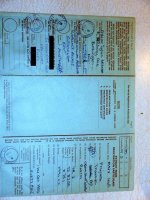I got to thinking about the TR2 I owned in 1969. It was only 14 years old but it was a rot box. If I remember correctly the frame outriggers on one side were held to the car by the floor boards. The "A" post on the drivers side was not attached to the sills. The door tended to flap when it was opened. It had Fiberglass front wings and a Fiberglass TR3 wide mouth front. I got rear ended and the Morris Minor that hit me nearly made it to the petrol tank because the rear end was rotten.
My point being how is it so many TRs seem to have survived so well in the US 45 years after I had my car in England. Just a larger population of cars or less salt on the roads?
The car I am working on is in far better condition than my old car. What I would give to get some bits off that car before it was scrapped. I did get the engine and transmission out of it for my second TR.
No info on that car but it was a similar age and slightly better condition.
Parts were still available from Standard Triumph.

This is a photo of the log book showing when I bought the car. TS 8255.
The car was first registered on Oct. 1 1955
Just some thoughts.
David
My point being how is it so many TRs seem to have survived so well in the US 45 years after I had my car in England. Just a larger population of cars or less salt on the roads?
The car I am working on is in far better condition than my old car. What I would give to get some bits off that car before it was scrapped. I did get the engine and transmission out of it for my second TR.
No info on that car but it was a similar age and slightly better condition.
Parts were still available from Standard Triumph.

This is a photo of the log book showing when I bought the car. TS 8255.
The car was first registered on Oct. 1 1955
Just some thoughts.
David

 Hi Guest!
Hi Guest!

 smilie in place of the real @
smilie in place of the real @
 Pretty Please - add it to our Events forum(s) and add to the calendar! >>
Pretty Please - add it to our Events forum(s) and add to the calendar! >> 

